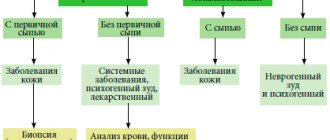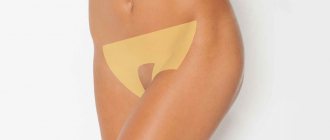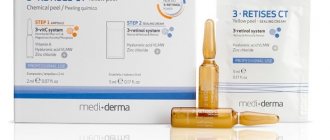Photoepilation is one of the first methods of hardware removal of unwanted hair on the face and body. Light exposure causes the destruction of hair follicles, as a result of which hair growth stops. The fairly long period of application of this method allows us to classify it as one of the most proven and reliable in terms of predicting results.
But photoepilation has some contraindications and can cause certain consequences that limit its use in a certain category of people.
This procedure may not be effective in people with dark or tanned skin, or if their hair is blond or gray. In addition, reviews from people with increased sensitivity to pain indicate discomfort during the procedure. But this feature does not detract from the benefits of photoepilation; the use of anesthetic drugs allows you to avoid unpleasant sensations.
How it works?
Melanin found in hair is capable of conducting and absorbing light. Pulsed light absorbed by melanin is “delivered” to the hair follicle. When exposed to energy, the bulb is destroyed. During the first three days, hair in the treated area begins to fall out due to the destruction of the hair bulb, which is also called the hair follicle.
- Find out the current offers
- Sign up for a consultation
Online registration
Laser hair removal
Cosmetology clinics offer their clients three types of hair removal devices: diode, alexandrite or neodymium laser.
Today, diode or alexandrite lasers with a wavelength of 755 nm are most often used in hair removal. They affect only target tissues that are susceptible to this type of radiation due to melanin, which actively absorbs light of a given wavelength. If there is any amount of melanin in the hair, even a minimal one, it will absorb radiation very well and accurately, and its hair follicle will heat up and be destroyed.
Since there is significantly less melanin in the skin, only the hair absorbs radiation, so the effect is very targeted, without affecting the tissue surrounding the hair follicle. During laser hair removal, there is no impact on the dermis, the tissues do not overheat, and no other processes are started, due to which laser hair removal has a very clear focus and is minimally traumatic for the skin.
As with photoepilation: the desired result in the area chosen by the patient is achieved only after completing the prescribed course. But the course itself has a shorter duration and averages 6-9 procedures.
What are the benefits of this procedure?
The effectiveness of the hair removal procedure remains for some time, so hair does not appear longer than after conventional bioepilation.
The advantages of photoepilation are:
- non-contact method of influence;
- minimal skin damage;
- impossibility of infection;
- speed of the procedure (one session takes from 5 to 30 minutes);
- “rejuvenation” of the skin (the principle of action for photoepilation and photorejuvenation is very similar) - collagen is produced, the skin is smoothed and thereby looks younger.
MAKE AN APPOINTMENT
How is a photoepilation session performed?
Before starting the procedure, a number of questions usually arise: how photoepilation occurs, how long the session lasts, and what sensations arise during the treatment.
To protect the retina from the influence of light flashes, the master and the client must wear safety glasses. Then a special gel is applied to the skin. The gel has a cooling, moisturizing effect, and also promotes uniform distribution of light fluxes and prevents burns.
The device is set to the desired mode, brought to the surface of the skin with the working area, and a flash is produced by pressing a button. The photoepilator is moved in stages, treating the entire area to be epilated. At the end of the treatment, remove excess gel and apply a soothing cream to the skin.
The duration of the session depends on the area of the site. When treating areas of increased sensitivity, a slight tingling sensation may be felt. Increasing the interval between flashes or adjusting the power of the photoepilator helps reduce discomfort. Modern devices are equipped with a cooling function, which helps reduce discomfort to a minimum.
How many procedures will be required?
With each photoepilation procedure, about 30% of the hair is removed. Thus, after 3-4 procedures, the patient is guaranteed to receive results. It is also recommended to do maintenance procedures once every 1-2 months.
photoepilation of the upper lip: before and after photos
Each procedure will last no more than half an hour. In this case, one flash affects several square centimeters of skin at once.
Comparison of photoepilation and laser hair removal
As already mentioned, from a scientific point of view, laser hair removal is a type of photoepilation, since both procedures refer to light methods of influencing hair follicles. The main differences between them can be summarized as follows:
| Photoepilation | Laser hair removal | |
| Light pulse source | Broadband light lamp | Laser |
| Length of generated light waves | Wide spectrum of light waves in the range of 400-1200 nanometers | Stable 755 nanometers |
| Method of influence | Impact on the follicle and skin | Targeted effect only on the follicle |
| Risk of overheating of the skin | Yes | Minimal |
| Power | Lower performance compared to laser systems | High power |
| Session duration | Average or maximum duration depending on individual sensitivity | Diode hair removal is the fastest method of hair removal. Alexandrite laser - medium or minimum duration depending on individual sensitivity. |
| Soreness | High level of pain | Diode laser hair removal – low level of pain Alexandrite hair removal – medium level of pain |
| Course duration | From 10 procedures | 6-9 procedures |
| Effect after the same number of procedures | 50-60% hair | More than 80-90% of hair |
Photoepilation. Contraindications
Photoepilation, as well as laser hair removal, has some contraindications:
- allergic reactions;
- exacerbation of chronic diseases (eczema, psoriasis, lichen planus, ichthyosis, atopic dermatitis, lupus erythematosus, scleroderma, cystic dermatoses, collagenosis, vasculitis, dyschromia)
- coronary heart disease and hypertension;
- herpes at the acute stage;
- phlebeurysm;
- keloid disease;
- skin neoplasms, malignant tumors;
- acute infectious diseases;
- parasitic diseases (helminthiasis, dermatozoonosis);
- pregnancy and breastfeeding (lactation).
Photoepilation of body hair is one of the most modern and safe methods. Painless hair removal is the motto of photoepilation in our clinic!
photoepilation of the face and back: before and after photos
Photoepilation - a solution to the problem of excess hair growth
Photoepilation is a hardware procedure for hair removal using light pulses. The technology is also relevant for men (for example, as an alternative to shaving). The procedures are carried out in courses and subsequently require repeated correction every 6-12 months.
The essence of the procedure and principle of operation
Photoepilation is a hardware hair removal technology that helps get rid of unaesthetic hair for a long time. The principle of its action is based on the influence of light pulses, which contribute to the destruction of hair follicles.
Photoepilation services are in demand not only for female clients. The male audience resorts to such procedures to remove excess vegetation in the back and abdomen. An epilation course will also replace daily shaving of the beard and mustache.
Indications for the procedure are hirsutism and hypertrichosis (intensive hair growth), skin tendency to irritation after regular depilation.
Photoepilation: how this method works
Pulsed light energy is absorbed by melanin, which is contained in the hair structure. There it is converted into thermal, destroying the follicle and stopping the appearance of vegetation. In this case, the hairs will not begin to fall out immediately, but several weeks after the first procedure.
How many procedures will be needed to achieve results?
The number of sessions is determined individually. Depending on the affected area, you will need to undergo from 3 to 10 procedures.
Is photoepilation forever or not?
To consolidate the effect obtained, in the future you will need to repeat the procedure every 1-1.5 years. The emergence of new vegetation will slow down significantly. There is no specific information on how long photoepilation lasts: it all depends on individual factors.
The effectiveness of photoepilation is best demonstrated by photos before and after the procedures.
Photoepilation at home
Today, many women use home photoepilators, which are sold in online stores. The principle of their operation is automatic color type recognition using a built-in sensor. The mode is manually adjusted, which allows you to use the epilator to treat any area of the body or face. The operation of the photoepilator depends on the flash limit (for good devices it is set within 50-300 thousand). Some devices also use Elos technology, which allows you to remove fine light hair. Certain models of epilators are also equipped with an anesthetic gel.
Despite the fact that most of these devices are approved by doctors in the European Union and the United States, performing photoepilation at home is not always safe. An incorrectly chosen regimen or exceeding the duration of the procedure will cause side effects.
Phototechnology, laser or electrolysis – which is better?
The difference between the first two types lies only in the possibility of individual settings of the equipment. For laser hair removal, light waves of only one length are used, which makes this procedure more aggressive for the skin.
In terms of the duration of the result, electrolysis is more effective, but the procedures are quite painful and require a lot of time.
Types of photoepilation
Depending on the equipment used, the following types of photoepilation are distinguished:
- IPL hair removal. The wavelength here is individually adjustable, which makes it possible to adjust the equipment without the risk of overheating the skin. The disadvantage of this type of hair removal is that it is not suitable for removing light hair. IPL technology is also used to treat rosacea and age spots (for photorejuvenation procedures).
- Quantum. Professional equipment is designed to process hairs containing the maximum concentration of melanin. Therefore, this type of hair removal is not suitable for removing fine vellus hair.
- LHE hair removal. The flash intensity here is low enough that this method does not require the use of a cooling gel. The downside of the technology is that processing leather takes longer.
- AFT hair removal. It combines the effects of light and laser energy, and a special filter prevents overheating of the skin. AFT technology copes with the removal of light hair and is safe for dark-skinned clients.
Preparing for the session
A month before your visit to a cosmetologist, refuse depilation with wax or sugar paste. In this case, the hairs can be shaved so that on the day of the procedure their length does not exceed 1-2 mm.
Before photoepilation, it is prohibited to take antibiotics and sedatives, or use self-tanners.
Is it possible to sunbathe before the procedure?
Light energy is dangerous for dark or tanned skin, as the concentration of melanin increases in it. To avoid burns, avoid visiting the beach or solarium at least 2 weeks before photoepilation and use SPF 40+ sunscreen.
How does photoepilation work in a salon?
The specialist selects a suitable program for the device, and then applies a conductor gel to the cleansed skin. The epilation area is preliminarily outlined with a cosmetic pencil. During the procedure, the master briefly applies the device’s attachment to the skin, and the tactile contact lasts no more than a second. At the final stage, the epilated area is treated with a restorative cream.
During hair removal, the client's eyes are protected with special dark glasses, under which cotton pads are also placed.
The following video will tell you how a photoepilation session occurs in aesthetic cosmetology clinics.
Does it hurt or not?
Photoepilation cannot be called a painless procedure. If the client has increased skin sensitivity (especially when epilating the intimate area), local anesthesia is performed before the session.
How long does the procedure take?
The duration of the session depends on the treatment area. Thus, epilation of the ears or antennae lasts 10-15 minutes, and the entire arms or legs - at least 1 hour.
Post-procedure care
Skin restoration takes at least 2 weeks. During this period, it is prohibited to sunbathe on the beach or in the solarium, or to visit the swimming pool, bathhouse or sauna. Also, do not pull out hairs with tweezers or wax strips.
Home care rules:
- In the first few days, avoid hot showers, use of alcohol-containing lotions, scrubs and fatty creams;
- treat epilated areas with Panthenol or other wound-healing ointment twice a day;
- To further moisturize the skin, drink at least 1.5 liters of purified water per day.
Negative consequences, their causes and solutions
Let's consider the side effects that arise as a result of photoepilation.
- Burns are the result of incorrectly selected equipment power, which indicates the unprofessionalism of the master. The risk of burning your skin increases with a fresh tan. First aid is the use of restorative ointments such as Panthenol or Solcoseryl.
- Hyperpigmentation and scars are a consequence of untimely healed burns. Only an experienced dermatologist can help solve this problem.
- Allergic reactions (itching, rashes) are the result of an incorrectly chosen anesthetic. The solution is to take antihistamines.
- Herpes appears in clients who have previously had problems with a similar disease. Preliminary intake of antiviral drugs will prevent its occurrence.
- Folliculitis (inflammation of the hair follicles) occurs as a result of visiting a pool or bathhouse during the period of skin restoration. Clients who suffer from excessive sweating are also at risk. Treatment medications are prescribed by a cosmetologist who conducts a course of procedures.
- Hypertrichosis (excessive hair growth) is a consequence of incorrectly calculated light output, when the exposure does not destroy the hair follicles, but, on the contrary, awakens inactive follicles. A good cosmetologist will advise a way out of the situation.
- Sweating problems after armpit hair removal are a consequence of an incorrectly selected program for the device. This problem will not arise if you contact a trusted specialist.
Contraindications and restrictions
Photo hair removal is one of those procedures that is prohibited during pregnancy and breastfeeding. It is not recommended if there are benign neoplasms - moles, papillomas and nevi - in the area of hardware influence.
Medical contraindications:
- Dermatological, cardiovascular, oncological, infectious diseases;
- tendency to allergic reactions and the formation of keloid scars;
- taking medications that increase the photosensitivity of the skin;
- varicose veins;
- diabetes;
- herpes.
Are you planning to undergo photoepilation on your face (for example, in the chin area or above the upper lip)? The procedure is not advisable if you have previously had tattooing or rejuvenation with gold threads.
Removing hair with a photo flash will negatively affect the quality of tattoos if they are located in the area of the hardware impact.
At what age can you start the procedure?
Officially, this hair removal is prohibited for minors. If there is an urgent need, you can start it even when you reach the age of 16, subject to the written consent of your parents.
How much does photoepilation cost: review of prices in Kyiv
The average price of one procedure on the Barb.ua portal is set at the level of prices for laser hair removal. The minimum cost of a session is from 125 UAH. (for hair removal in the ear area), maximum – from 1200 UAH. (for legs completely). Photoepilation of the back costs from 500 UAH, and bikini area – from 720 UAH.
Conclusion. Arguments for and against the procedure
Let’s summarize and consider the main advantages and disadvantages of photoepilation.
Pros:
- Suppression of further hair growth. New vegetation appears much more slowly and in smaller quantities.
- Long lasting results. Compared to conventional depilation, new hair grows after a course of photoepilation in 1-2 years.
Minuses:
- Risk of side effects. Reviews on the forums indicate: before starting photoepilation, you should make sure of the professionalism of the specialist. There are high risks of burns and hyperpigmentation, so choosing the wrong specialist is simply dangerous.
- Price. The procedure cannot be called financially accessible. It is important to carry out the course to the end, otherwise you will not see the desired effect.
What was your experience with photoepilation? We welcome comments from readers on the blog and in communities on social networks.
If, after reading our article, you decide to sign up for a photoepilation session with a professional, just use our catalog, it contains the best cosmetologists in Kharkov, Kherson, Vinnitsa and many other cities of Ukraine.
Phototeration capabilities:
- photoepilation
- photorejuvenation
- photo of removal of blood vessels, telangiectasias, hemantoma, treatment of rosacea...
Phototherapy, a technique of hardware therapeutic cosmetology, is effective and efficient, but at the same time technically complex, requiring certain knowledge from the one who carries it out.
The result of the procedure will depend on the degree of qualification of the specialist. It is necessary to have a medical education to clearly understand the mechanism of operation of photo equipment. Otherwise, it is impossible to calculate the parameters for the procedure and the number of required sessions, which will be individual for clients.
Read our page; we will describe the main stages and principles of phototherapy.
Photoepilation is a widespread method of getting rid of unwanted hair on any part of the body. Shaving or depilation gets rid of unwanted hair only for a while, while photoepilation is an effective and reliable method that destroys the hair follicle.
The photoepilation procedure is not cheap. But judge for yourself how much you have to spend on constant depilation, taking into account special products and cosmetics, and most importantly time.
The operating principle of photoepilation based on IPL is an intensely pulsating light that penetrates into the deep layers of the skin, which acts as a target on the melanin pigment contained in the hair follicle. Light is absorbed by the melanin pigment and converted into thermal energy, which destroys the hair follicle. Thus, the more melanin in the hair, the higher the effect on the hair bulb. It is clear that where hair follicles are destroyed, hair will no longer grow.
Other methods for getting rid of unwanted hair:
Electrolysis
Waxing
What to do after the procedure
Immediately after the procedure, swelling, redness and slight pain in the treated area may be observed. These effects should subside within a couple of hours. If they persist, it is necessary to cool the treated area. It is possible to use painkillers.
Also, the salon may recommend using Panthenol or other drugs with a similar effect for some time.
The rehabilitation period after photoepilation ranges from five to seven days . At this time, it is advised to refrain from visiting the pool, sauna, bathhouse, as well as from applying cosmetics, especially alcohol-containing products, to the face.
After the procedure, you should not sunbathe for two weeks, limit your time in the sun and use sunscreen (SPF 30 or higher).
Causes of increased facial hair
The face is the most problematic area for hair removal:
- Firstly, because this area is always open and all the damage on it is too noticeable.
- Secondly, since the skin on the face is very sensitive and any impact on it can lead to undesirable results in the form of allergic rashes, tumors, soreness, etc.
If facial hair is a natural factor for men, then for women it usually forms the basis of complexes and discomfort. There may be several reasons for increased facial hair in women:
- hormonal disorders (excess of male hormones androgens, which can be a consequence of diseases of the ovaries, adrenal glands, brain and pregnancy);
- metabolic and endocrine disorders associated with bad habits, malfunction of the thyroid gland, obesity;
- heredity;
- side effect when treated with hormonal drugs;
- period of puberty.
Did you know?
Excessive hair growth on the body of women due to an excess of male hormones is called hirsutism in medical practice. Excessive hair growth – hypertrichosis. It can be observed in both women and men.
It is women who most often look for ways to get rid of problematic facial hair and are faced with the problem of choice, since not all methods are suitable for this part of the body. For example, when shaving, hair will grow more intensively, thicker, and stubble will appear. Waxing and sugaring are painful and lead to severe irritation. The most effective methods of facial hair removal are laser and photoepilation.
Is it possible to use photoepilators for home use?
More and more women prefer to buy epilators, devices that can help get rid of unwanted hair on the body at home. Modern manufacturers have begun to produce photoepilators on the market for these products. This type of device closely resembles professional photoepilation devices, but their power is much lower. Previously, manufacturers specifically produced a device with such a low power that buyers could only use it as a maintenance procedure. You can use such a home photoepilator only after full professional photoepilation. In addition, manufacturers were concerned about the correct use of such technology.
Now they have begun to produce more powerful devices that closely resemble professional ones. They are equipped with special settings for wave depth, power, etc. The buyer has the right to independently adjust the parameters for himself.
It is important to know that each photoepilator that is offered for sale must have an appropriate quality certificate. Often such certificates are issued by the US Quality Assurance Organization. It should be noted on the packaging or in the instructions for the device that the product has passed quality control by the FDA.
If you decide to use a photoepilator for home use, then you should learn in detail about its principle of operation and technology for performing the procedure. You need to clearly know its strength, power, wave depth, etc. You need to select an epilator for your skin and hair type. If you still can’t make a choice, then it is better to seek help from a qualified cosmetologist who should know the features of the selected models. He can help you choose the right device.
Skin care after photoepilation
Skin care after photoepilation is reduced to moisturizing and protecting the treated area from aggressive external factors, which include:
- sunbathing (prohibited for the next 30 days);
- saunas, steam baths, swimming pools (not recommended in the first 3 days after hair removal);
- alcohol-based cosmetics (3-day limit).
It is allowed to moisturize the treated areas with light creams with dexpanthenol or special skin care products after hair removal.
Preparing the face
As with other methods, the effectiveness of photoepilation directly depends on proper preparation for it. The first step is to seek advice from a specialist, for example a dermatologist, who should determine whether you have contraindications to this procedure.
To prepare your face for photoepilation, you need to:
- stop sunbathing two weeks before the scheduled session;
- do not use self-tanning preparations;
- when going outside, protect your face with a hat with a visor or wide brim, and also use sunscreen with a filter of at least SPF 30;
- a few weeks before doing photoepilation on the face, abandon any methods of hair removal, including plucking and waxing;
- Avoid taking medications, in particular antibiotics and tranquilizers.
Advice ! The length of the hairs on the day of the procedure should be 1-2 mm.











